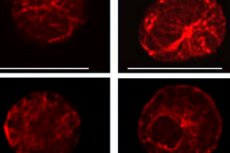Nye publikasjoner
Det første stadiet av allergiske reaksjoner er oppdaget, noe som åpner for nye muligheter for forebygging
Sist anmeldt: 02.07.2025

Alt iLive-innhold blir gjennomgått med medisin eller faktisk kontrollert for å sikre så mye faktuell nøyaktighet som mulig.
Vi har strenge retningslinjer for innkjøp og kun kobling til anerkjente medieområder, akademiske forskningsinstitusjoner og, når det er mulig, medisinsk peer-evaluerte studier. Merk at tallene i parenteser ([1], [2], etc.) er klikkbare koblinger til disse studiene.
Hvis du føler at noe av innholdet vårt er unøyaktig, utdatert eller ellers tvilsomt, velg det og trykk Ctrl + Enter.

Forskere ved Duke-NUS Medical School har identifisert hvordan en kjede av hendelser starter etter at en person kommer i kontakt med et allergen som peanøtter, sjømat, pollen eller støvmidd. Oppdagelsen deres, publisert i tidsskriftet Nature Immunology, kan føre til utvikling av legemidler for å forhindre alvorlige allergiske reaksjoner.
Mastceller, en type immuncelle, er kjent for å forveksle et ufarlig stoff som peanøtter eller støvmidd med en trussel og frigjøre en første bølge av bioaktive kjemikalier mot denne oppfattede trusselen. Når mastceller, som befinner seg under huden, rundt blodårer og i slimhinnen i luftveiene og mage-tarmkanalen, samtidig frigjør sine forhåndslagrede bioaktive stoffer i blodet, kan det oppstå øyeblikkelig og systemisk sjokk som kan være dødelig uten rask inngripen.
Ifølge Verdens helseorganisasjon (WHO) lider mer enn 10 % av verdens befolkning av matallergier. Etter hvert som antallet allergier øker, øker også forekomsten av matindusert anafylaksi og astma. I Singapore rammer astma ett av fem barn, og matallergier er allerede den viktigste årsaken til anafylaktisk sjokk.
Duke-NUS-teamet oppdaget at frigjøringen av mastcellegranuler som inneholder bioaktive kjemikalier kontrolleres av to komponenter i et intracellulært multiproteinkompleks kalt inflammasomet. Frem til nå har det bare vært kjent at disse inflammasomproteinene spontant samles i immunceller for å skille ut løselige kjemikalier som varsler andre deler av immunsystemet når infeksjon oppdages.
Professor Soman Abraham, professor emeritus i patologi ved Duke University, som ledet studien mens han jobbet i Duke-NUS Emerging Infectious Diseases Programme, sa: «Vi fant ut at komponenter av inflammasomet spilte en overraskende viktig rolle i transporten av mastcellegranuler, som normalt er pakket i midten av cellen, til celleoverflaten hvor de frigjøres. Denne uventede oppdagelsen gir oss et presist mål for intervensjon for å forhindre hendelsesforløpet initiert av mastceller som fører til anafylaktisk sjokk.»
Professor Abraham og teamet hans undersøkte mus som manglet ett av to inflammasomproteiner, NLRP3 eller ASC. Da disse dyrene ble utsatt for allergener, fikk de ikke anafylaktisk sjokk.
Anafylaktisk sjokk ble imidlertid observert da NLRP3- og ASC-proteiner i mastceller samlet seg og bandt seg til individuelle intracellulære granuler, og dannet et kompleks forskerne kalte et granulosom, som fremmet bevegelsen av granuler langs spor dannet av cytoskjelettet inne i mastcellen, omtrent som de "fester seg til togskinner".
Dr. Pradeep Bist, første medforfatter av artikkelen og hovedforsker i Duke-NUS Emerging Infectious Diseases Programme, sa: «Da mastceller ble aktivert, observerte vi rask bevegelse av granuler langs dynamiske veier kjent som mikrotubuli til cellemembranen, hvor disse granulene umiddelbart ble frigjort fra cellen. I mastceller som manglet NLRP3- eller ASC-proteiner fant vi imidlertid ingen tegn til intracellulær bevegelse av granuler, og ingen av disse granulene ble frigjort.»
Etter å ha demonstrert rollen til NLRP3 og ASC i granulatransport, vendte teamet seg til kjente inflammasomhemmere for å se om de kunne forhindre denne hendelsen.
Ved å bruke et inflammasomblokkerende legemiddel, kalt CY-09, som er svært likt de som brukes i kliniske studier for kroniske inflammatoriske sykdommer, ga de behandlingen til mus før de ble eksponert for allergenet. De fant ut at de i sin prekliniske modell effektivt kunne forhindre anafylaktisk sjokk med legemidlet.
Dr. Andrea Mencarelli fra Institute of Immunotherapy ved Shanghai Jiao Tong University School of Medicine, som var den første medforfatteren av artikkelen mens hun jobbet i Duke-NUS Emerging Infectious Diseases Programme, sa: «Bemerkelsesverdig nok, ved å bruke et legemiddel som spesifikt blokkerte aktiviteten til inflammasomproteiner, var vi i stand til selektivt å blokkere frigjøringen av forhåndslagrede mastcellekjemikalier uten å påvirke andre potensielt gunstige mastcellefunksjoner.»
Selv om dette ikke er en kur, kan det gi personer med alvorlige allergier et nytt verktøy for å forhindre at en potensielt farlig reaksjon oppstår. For tiden iverksettes akuttbehandling umiddelbart etter at de første symptomene oppstår. Disse behandlingene må brukes innenfor et smalt tidsvindu for å være effektive, og de har også alvorlige bivirkninger.
«Jeg kan se hvordan dette kan gi trygghet til foreldre til barn med alvorlige matallergier når de står overfor situasjoner der det er umulig å være sikker på at det ikke er noen risiko for eksponering. Selv om vi ikke ønsker å deaktivere denne delen av immunforsvaret i lange perioder, kan det potensielt gi kortsiktig beskyttelse», sa professor Abraham, hvis team nå jobber med å optimalisere doseringen og brukshyppigheten av legemidlet for å oppnå best mulig beskyttende effekt mot anafylaktisk sjokk.
«Etter det håper vi å kunne gjøre det samme for astma og allergiske hudreaksjoner.»
Professor Patrick Tan, seniordekan for forskning ved Duke-NUS, sa: «Dette gjennombruddet har et enormt translasjonspotensial og representerer et paradigmeskifte ikke bare for videre forskning, men også for å forbedre livskvaliteten til de som er i faresonen for alvorlige allergiske reaksjoner. Det er et lyspunkt, spesielt for foreldre til små barn som lever med konstant angst.»
